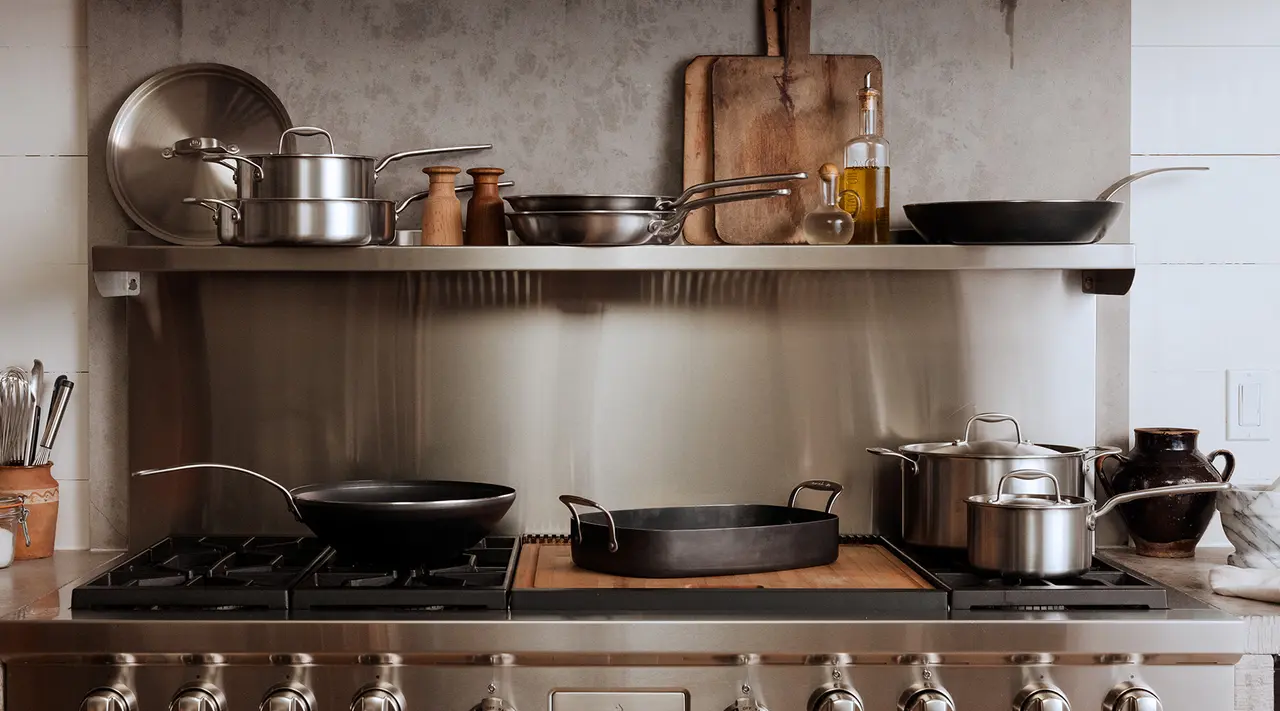Carbon steel and non stick cookware are both beloved for different reasons: carbon steel for its high-heat capabilities and lightweight build, and non stick for its easy-to-clean, stick-free surface. Together, these two types of cookware make up the perfect duo for any cook.
If you're deciding which one to get first or wondering if you need both, don’t fret. Here’s how they compare in nine different categories.
Construction Materials

The differences between non stick and carbon steel starts early—before they're even constructed.
Carbon Steel
Carbon steel is made from 99% iron and 1% carbon. Since carbon steel is stamped, rather than poured like cast iron, it's much lighter weight but can still boast the same heat retention. Due to its construction materials, carbon steel is near indestructible and incredibly durable.
Like cast iron, carbon steel requires seasoning to protect the raw metal from rust. Over time and with cooking (particularly fatty foods like bacon), this seasoning builds up to become a naturally non stick patina that's perfect for cooking even the most delicate ingredients like eggs and fish.
Non Stick
Non stick pans feature a metal base (typically constructed from either aluminum or stainless steel) with durable non stick coating applied atop the pan’s surface to prevent ingredients from sticking.
Both our ProCoat and CeramiClad Non Stick lines feature multiple layers of professional-grade coating applied atop our Award-Winning Stainless Clad, ensuring even heating and mess-free cleanups.
Cooking Surface
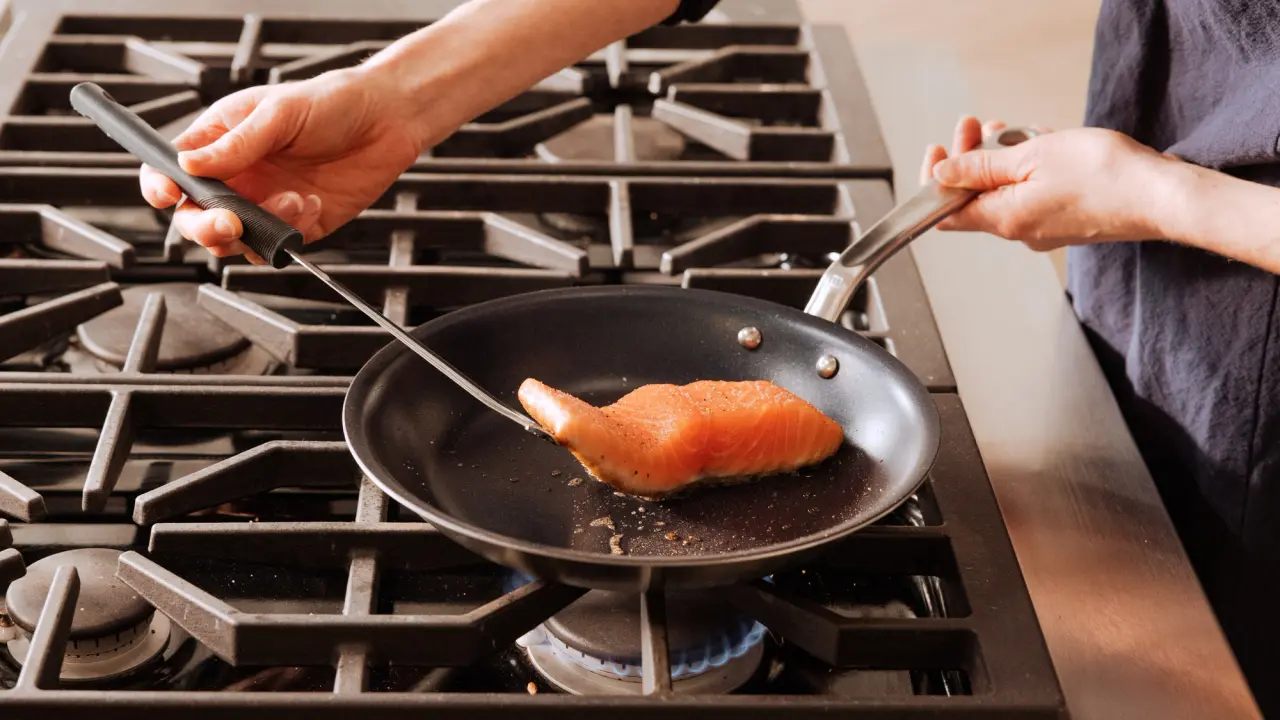
Both carbon steel and non stick cookware feature a durable non stick surface that prevents ingredients from sticking to the pan, but the main difference lies in how this layer is achieved.
Carbon Steel
Carbon steel’s "naturally non stick" layer is achieved through the seasoning process, where a small amount of high smoke-point oil—the Made In Studio prefers grapeseed oil or Seasoning Wax, but any unflavored oil works—is heated over high temperatures to fill in the small pores of the pan’s metal surface.
When heated, the oil dries out and becomes a slick coating that's bonded to the surface of the pan, also called polymerization. This layer of protection on the pan also helps keep moisture from penetrating the metal, which may cause it to rust.
Over time and with use, the surface builds up with additional layers of heated oil and fat to become more and more non stick. If the layer becomes compromised, rusts, or is no longer non stick, then the pan can easily be stripped and reseasoned.
Non Stick
On the other hand, non stick cookware comes with its durable no-stick coating out of the box. This easy-to-clean surface ensures easy cooking and even easier cleaning, without fear of ingredients sticking.
However, there are a few caveats about non stick coating to keep in mind: it's relatively delicate and needs to be treated with care (namely by using the proper utensils), and most importantly, it does not last forever and will eventually wear out. High-quality ceramic and traditional non stick can last for a few years with the proper care, but none will last as long as carbon steel.
Care and Maintenance
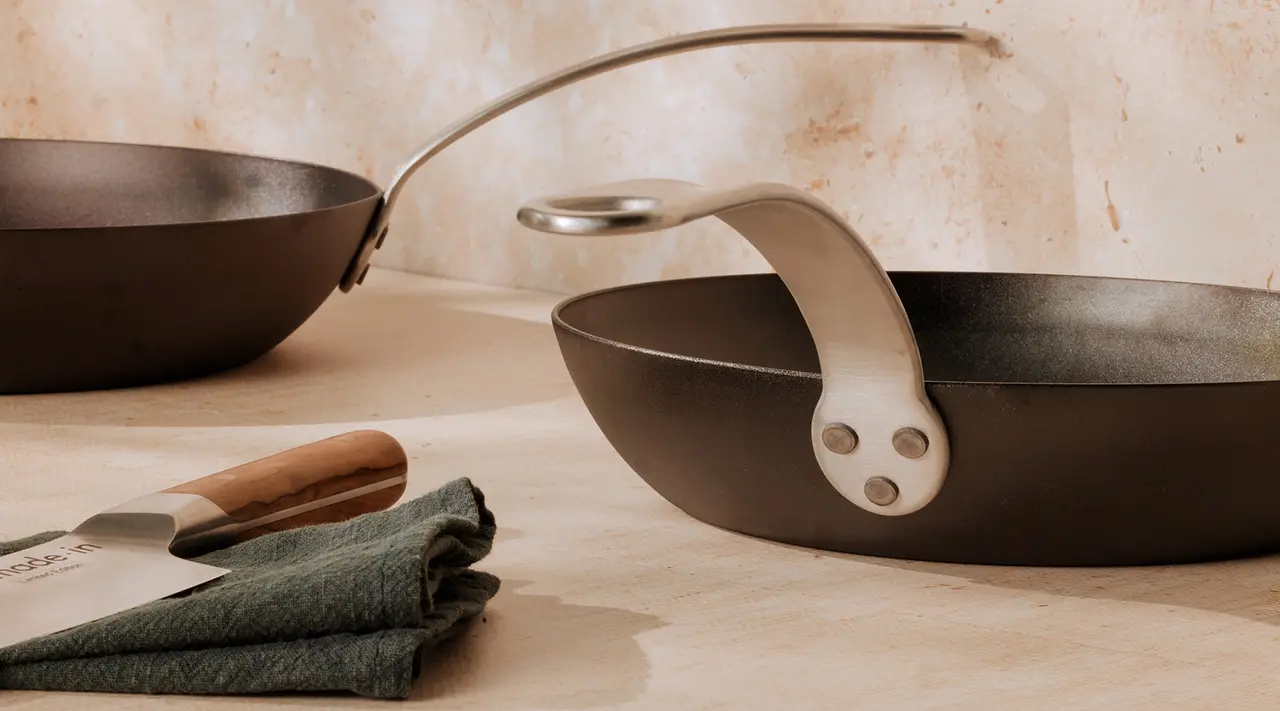
Non stick and carbon steel are similarly easy to care for. We don't recommend putting any of our cookware in the dishwasher, as harsh cleaners can damage the surface (and it’s easy to get scratched or dented by other dishes).
Before cleaning either pan, make sure it is fully cooled and you have removed as much food as possible.
Cleaning Carbon Steel
Carbon steel is similar to cast iron in that most of the time, you don't have to clean it with soap and water—often, you can just wipe out residue with a clean paper towel and be on your way.
If stuck on food bits remain, sprinkle a tablespoon each of neutral oil and kosher salt and scrub at the residue with a paper towel, bristle brush, or clean dish sponge. You can also add enough water to cover the debris and boil it while gently scraping at the residue with a wooden spoon until it's fully loosened. If you must introduce water, be sure to throughly dry it afterwards on a low setting on the stove—the high iron content of carbon steel all but guarantees rust if exposed to water for prolonged periods.
Check out our guides for a deeper dive into cleaning carbon steel or removing rust.
Cleaning Non Stick
If you have high-quality non stick pans, all you need is dish soap and the soft side of a dish sponge, which will clean your pan in a matter of moments. Be sure to avoid abrasive cleaning utensils like steel wool, as these can permanently damage the coating of your non stick.
Our guide on cleaning non stick cookware and cleaning our CeramiClad™ has more details and step-by-step instructions for tackling different kinds of mess without damaging the surface of your non stick.
Cooking Capabilities

Carbon Steel
Since carbon steel is safe up to 1200F, it's ideal for all types of high-heat cooking, from the stovetop to the grill to even over an open fire. This is the perfect pan for searing steaks or other proteins or getting a char on your grilled veg.
Non Stick
Non stick cookware is perfect for cooking delicate foods that would stick to other pans, like fish and egg dishes. Since the base of our ProCoat and CeramiC;ad™ Non Stick is our Award-Winning Stainless Clad, any of our ProCoat pieces can be used in the oven up to 500F, and CeramiClad™ up to 550F—making this the perfect pan for oven-finished frittatas or Dutch babies with minimal cleanup.
Durability

Carbon Steel
No matter if you rust it by accident, put a nick on the surface, or make your best attempt at cooking an omelet, there’s almost always a way to fix near-indestructible carbon steel.
Rust can be cleaned off with the help of vinegar and water, a nick on the surface of the pan will fill in with seasoning, and the biggest of messes can be scrubbed off and reseasoned.
Non Stick
While non stick cookware will not have the same lifespan as carbon steel, it can last for years when given proper care. To avoid replacing your pan every year, we'll reiterate:
- Wash by hand only (with a dish sponge, never something abrasive like steel wool);
- Cook with non stick-friendly utensils;
- Remember to check oven safety guidelines—ours are safe up to 500F, but if any part of the pan is plastic then it cannot safely be used in the oven.
Ease of Use

Carbon Steel
Carbon steel seems intimidating when first unboxed, but like most things, gets easier the more you use it. Once the seasoning has been applied (or you unboxed a preseasoned pan), we recommend cooking with fatty ingredients, like steak or bacon, to kick start the buildup of your pan's naturally non stick layer.
Note that acidic foods (like citrus, wine, vinegar, and tomatoes) can strip the seasoning on your carbon steel cookware, but you can always re-season your pan if this happens. For more tips on conquering cooking with carbon, check out our guide.
Non Stick
Non stick is one of the easiest cookware materials to get the hang of. You can cook just about anything with ceramic or traditional non stick cookware, just be sure to always preheat your non stick with food or oil in them—prolonged exposure to heat without anything inside the pan can cause your pan to degrade faster or warp the coating.
The only restriction to keep in mine when cooking with non stick cookware is the cooking temperature—for example, our ProCoat Cookware should be kept at 500F and CeramiClad™ at 550F or under, and other brands recommend keeping your pan on medium-low only.
Heat Conductivity

Carbon Steel
Overall, carbon steel is a superior heat conductor—it can be heated to extremely high temperatures and responds quickly to changes in temperature. While it can handle heat up to 1200F, it is by no means necessary to cook over high every time—in fact, most of the time, you’ll achieve perfect sears and chars over low to medium heat.
Non Stick
The heat conductivity of non stick cookware ultimately depends on its construction. Aluminum bases are excellent heat conductors but aren't durable, which is why we used an aluminum core in our Stainless Clad construction process. The result is a non stick pan with exceptional heat conductivity and no hot spots.
Price
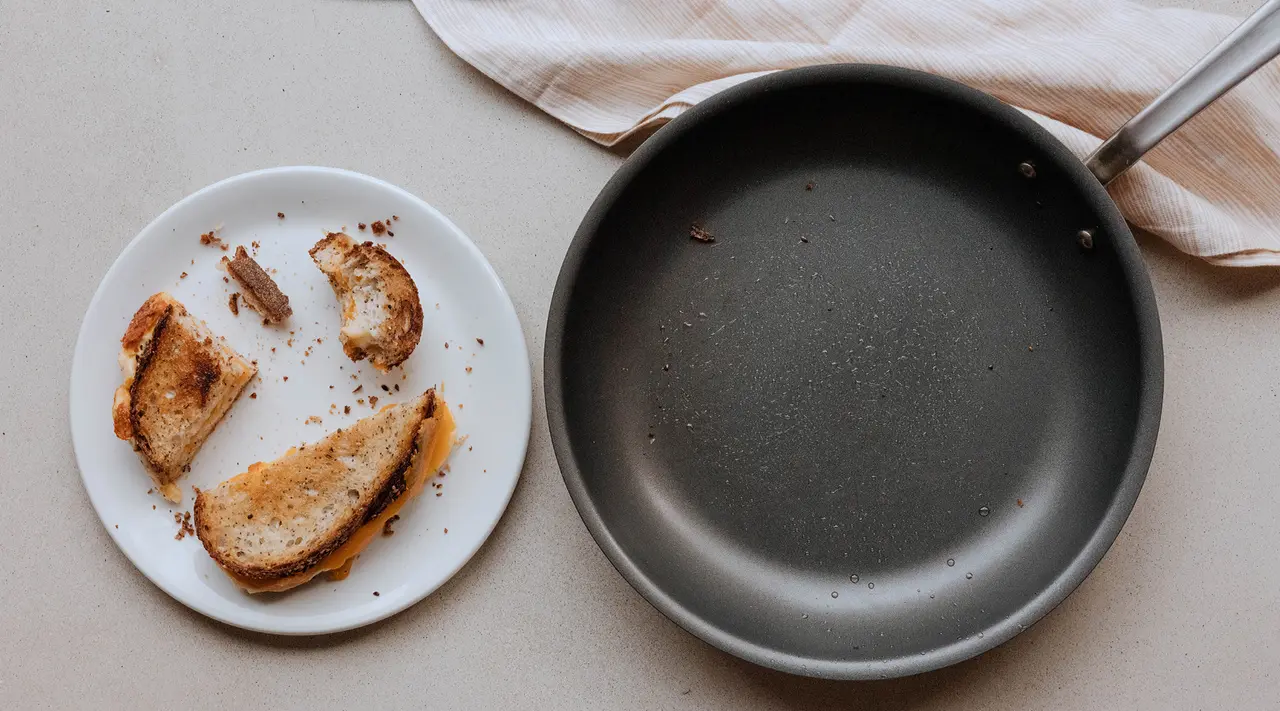
Pricing for both of these materials will typically vary depending on the quality. Our Carbon Steel Frying Pans range from $89 for an 8" Seasoned Frying Pan to $129 for a 12" Seasoned Frying Pan. Our CeramiClad™ ProCoat Non Stick Frying Pans range from $119 for an 8" Frying Pan to $149 for a 12" Frying Pan.
Which One Should You Buy?
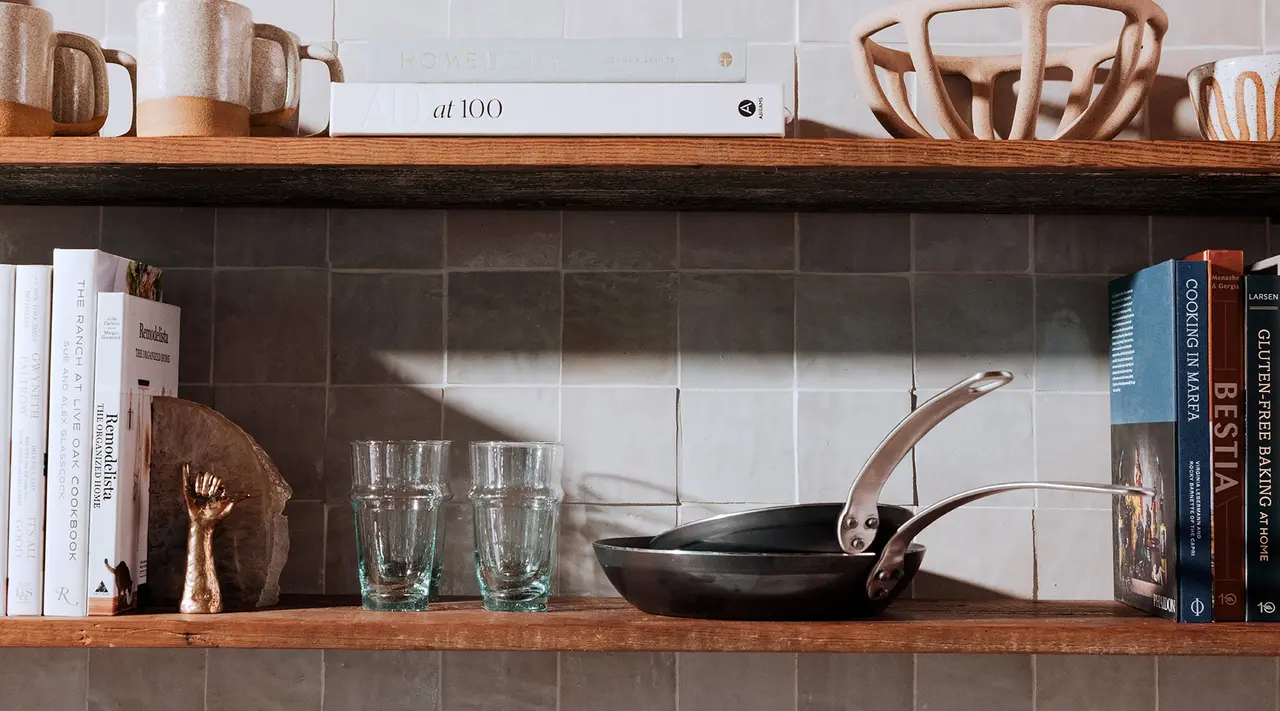
Carbon steel and non stick cookware are the perfect complement to one another. Both deserve to be in your kitchen, especially since they excel at different tasks.
For chef-approved, high-heat cooking—like seared steak and charred veg—turn to carbon steel. It’s nearly indestructible, and our collection offers a variety of shapes and sizes like a Wok, Pizza Steel, and Roasting Pan.
For delicate cooking, such as scrambling eggs or searing fish, we recommend non stick. The easy-to-clean coating is extremely durable and long-lasting, whether you opt for ProCoat or CeramiClad™.
Ready to Shop?
Ultimately, we recommend thinking of these pans as complements, not competitors, of a well-stocked cookware collection. Together, they'll help you see the difference chef-loved, home cook-approved pans can make in your day-to-day, whether searing steaks or scrambling eggs.
